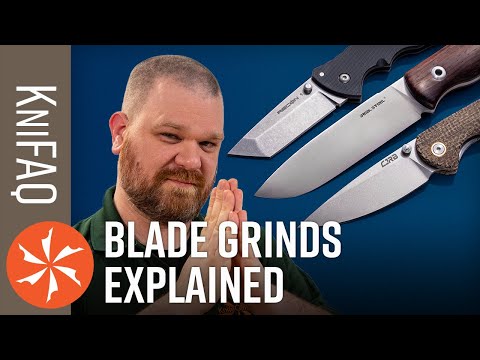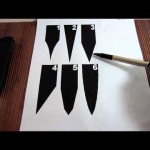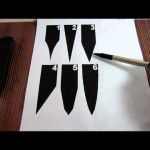
99d8c1186d0cf855f2eeecaede4afc8b
Knives are essential tools in the kitchen, and the type of knife grind you choose can make a big difference in how well your knife performs. In this article, we’ll explain the different types of knife grinds and how they affect the performance of your knife. We’ll also discuss the advantages and disadvantages of each type of grind, so you can make an informed decision when selecting a knife. Finally, we’ll provide some tips on how to maintain your knife and keep it in top condition. Read on to learn more about knife grinds and how to choose the right one for your needs.
What are the different grinds on knives
Knives come in a variety of shapes and sizes, and the grind of a knife is one of the most important factors in determining its performance. The grind of a knife is the shape of the blade, and it affects how the knife cuts and how it feels in the hand. There are several different types of grinds, each with its own advantages and disadvantages.
Flat Grind
The flat grind is the most common type of grind and is found on most kitchen knives. It is created by grinding the blade in a straight line from the spine to the edge. This creates a blade with a V-shaped cross-section, with the edge being the thinnest part. The flat grind is easy to sharpen and is a good all-purpose grind.
Hollow Grind
The hollow grind is created by grinding the blade in a concave shape from the spine to the edge. This creates a blade with a U-shaped cross-section, with the edge being the thinnest part. The hollow grind is very sharp but can be difficult to sharpen. It is often used on hunting and skinning knives.
Chisel Grind
The chisel grind is created by grinding one side of the blade in a straight line from the spine to the edge, while the other side is left unground. This creates a blade with a chisel-like shape, with the edge being the thinnest part. The chisel grind is very sharp and is often used on Japanese knives.
Convex Grind
The convex grind is created by grinding the blade in an arc from the spine to the edge. This creates a blade with a convex cross-section, with the edge being the thinnest part. The convex grind is very strong and is often used on axes and machetes.
Scandinavian Grind
The Scandinavian grind is created by grinding the blade in a curved shape from the spine to the edge. This creates a blade with a flat cross-section, with the edge being the thinnest part. The Scandinavian grind is very sharp and is often used on Scandinavian knives.
Conclusion
The grind of a knife is an important factor in determining its performance. There are several different types of grinds, each with its own advantages and disadvantages. Knowing the different grinds and how they affect the performance of a knife can help you choose the right knife for your needs.
What is the difference between V grind and Scandi grind
When it comes to sharpening knives, there are two main types of grinds: V grind and Scandi grind. Both of these grinds have their own unique advantages and disadvantages, and it is important to understand the differences between them in order to choose the right one for your needs.
V Grind is a type of grind that is created by grinding the blade of a knife in a V-shaped pattern. This type of grind is often used for knives that are used for slicing and cutting, as it provides a very sharp edge that is easy to maintain. The downside to this type of grind is that it can be difficult to sharpen, as the V-shaped pattern can be difficult to replicate.
Scandi Grind is a type of grind that is created by grinding the blade of a knife in a flat pattern.
This type of grind is often used for knives that are used for chopping and slicing, as it provides a very sharp edge that is easy to maintain. The downside to this type of grind is that it can be difficult to sharpen, as the flat pattern can be difficult to replicate.
In conclusion, the main difference between V grind and Scandi grind is the shape of the blade. V grind is a V-shaped pattern, while Scandi grind is a flat pattern. Both of these grinds have their own advantages and disadvantages, and it is important to understand the differences between them in order to choose the right one for your needs.
What is the difference between a full flat grind and a hollow grind
When it comes to knives, there are two main types of grinds: full flat grind and hollow grind. Both grinds have their own advantages and disadvantages, and it is important to understand the differences between them in order to make an informed decision when purchasing a knife.
Full flat grind is a type of grind that is created by grinding the blade from the spine to the edge in a single, flat plane. This type of grind is often used for hunting and outdoor knives, as it provides a strong, durable edge that is easy to sharpen. The downside of a full flat grind is that it can be difficult to sharpen, as the blade must be ground evenly across the entire surface.
Hollow grind is a type of grind that is created by grinding the blade from the spine to the edge in a concave shape. This type of grind is often used for kitchen knives, as it provides a sharp, thin edge that is easy to sharpen. The downside of a hollow grind is that it is not as strong or durable as a full flat grind, and it can be more prone to chipping or breaking.
In conclusion, the main difference between a full flat grind and a hollow grind is the shape of the blade. Full flat grinds are stronger and more durable, while hollow grinds are sharper and easier to sharpen. It is important to consider the type of knife you are purchasing and the intended use when deciding which type of grind is best for you.
What is the sharpest knife grind
Knives come in a variety of shapes and sizes, and the sharpness of a knife is determined by its grind. A knife grind is the shape of the blade, and it affects the way the knife cuts. The sharpest knife grind is the convex grind, which is also known as the Scandinavian grind.
The convex grind is created by grinding the blade in an arc shape, with the edge of the blade curving outward. This grind creates a very sharp edge that is strong and durable. It is the sharpest grind because it has the most surface area in contact with the material being cut.
The convex grind is often used on hunting knives and other outdoor knives. It is also used on kitchen knives, as it is very sharp and can easily cut through tough materials. It is also easy to sharpen, as the curved shape of the blade allows for a more even sharpening.
The convex grind is not the only sharp knife grind. Other sharp grinds include the flat grind, the hollow grind, and the chisel grind. Each of these grinds has its own advantages and disadvantages, and the best grind for a particular knife will depend on its intended use.
No matter what type of knife you have, it is important to keep it sharp. A sharp knife is safer to use and will make cutting easier. The convex grind is the sharpest grind, and it is a great choice for many types of knives.
We hope this article has been helpful in understanding the different types of knife grinds. We wish you the best of luck in finding the perfect knife for your needs. Goodbye and take care!













